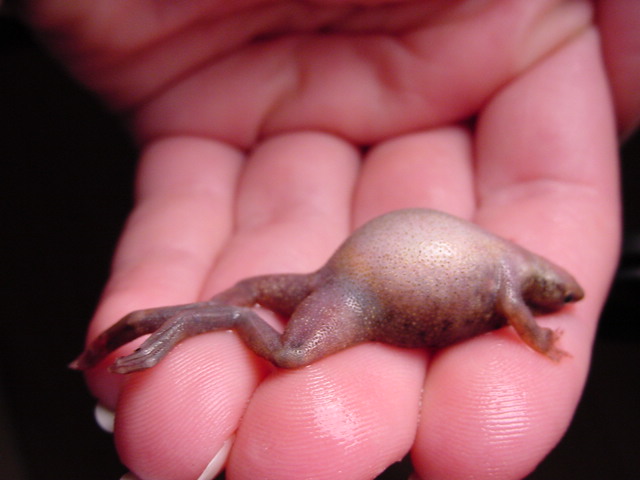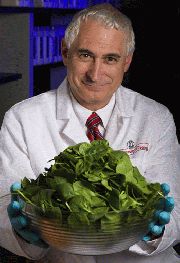Gonzalo Erdozain of Kansas State University writes:
As a pre-veterinary student working for a food safety professor, I’ve heard of Salmonella.
When I arrived at the vet clinic where I also work on Saturday morning, I encountered a pink plastic  container filled with a clear solution, which looked like water. The container had tape across it saying, "Water + Bleach – leave soaking overnight, dead turtle."
container filled with a clear solution, which looked like water. The container had tape across it saying, "Water + Bleach – leave soaking overnight, dead turtle."
Because turtles, and African Dwarf Frogs (right), are an excellent source of Salmonella I pondered:
• was soaking the container over night with bleach and water enough;
• was there enough bleach in that water solution to kill the salmonella;
• since I’ll be washing it, should I wear gloves or just bleach it again;
• should I bleach my hands after bleaching the container; and,
• is the turtle still around for that warm soup on this cold day?
I cook at home, and I don’t want to make my wife barf. Had I not taken the precautions of making sure I properly washed and disinfected my hands, I could have easily brought the pathogen home, passed it on to everything I touched and eventually made it into our dinner.
Beat the bug and wash your hands. The latest amphibian assault involves 48 people sick with Salmonella serotype Typhimurium in 25 states linked to water frogs that commonly live in aquariums or fish tanks.
Salmonella, or any foodborne pathogen can come from dead turtles, kissing frogs (sorry Disney, those happily ever afters only work in cartoons), dog’s treats, or by touching that Wii or PS3 remote your buddy just touched after pooping and not washing his hands.
If you thought your wife got mad at you for laying on the couch all Sunday, multiply that by 100 for making her barf like the girl on the exorcist and shit like Harry (Jeff Daniels) in Dumb and Dumber all at the same time.
More about Gonzalo:
I’ve always been fascinated by creatures. From a young age until now. If I remember correctly, my first pet was a frog I found on our family’s island in Buenos Aires, Argentina, which was flushed down the toilet by my younger brother to see if it could swim. I’ve moved on, and had dogs, horses, parrots and a few other pets, and now I own a crazy yellow lab (don’t ask). But it was this passion which drove me to K-State to pursue a career in Veterinary Medicine and which led me to this online publication, for which I now write?

 Willard showed up in a cameo in yet another movie – the guy’s everywhere – and I was telling her about this wildly satirical talk show featuring Willard as sidekick Jerry Hubbard, and host Barth Gimble, played by Martin Mull.
Willard showed up in a cameo in yet another movie – the guy’s everywhere – and I was telling her about this wildly satirical talk show featuring Willard as sidekick Jerry Hubbard, and host Barth Gimble, played by Martin Mull. When it comes to offering bad food safety advice,
When it comes to offering bad food safety advice, .jpg) We’ve been saying for a couple of years that water temperature is not a critical factor
We’ve been saying for a couple of years that water temperature is not a critical factor(1).jpg)
 Residents are advised not to drink water from a spring located one-quarter mile north of the intersection of routes 22 and 43.
Residents are advised not to drink water from a spring located one-quarter mile north of the intersection of routes 22 and 43..jpg) On Monday, the
On Monday, the  Michael Doyle (left), professor and director of the Center for Food Safety at the University of Georgia in Griffin, Ga. (Doyle developed an antimicrobial technology that was licensed earlier this year by the makers of Fit produce wash.) said,
Michael Doyle (left), professor and director of the Center for Food Safety at the University of Georgia in Griffin, Ga. (Doyle developed an antimicrobial technology that was licensed earlier this year by the makers of Fit produce wash.) said, That’s the dream lede for a
That’s the dream lede for a  And 30 minutes ago after returning from the beach, Sorenne peed on me and the towel she was wrapped in (that’s us, right, watching the sunset in Venice, Florida, last night).
And 30 minutes ago after returning from the beach, Sorenne peed on me and the towel she was wrapped in (that’s us, right, watching the sunset in Venice, Florida, last night).
 with other glasses throughout the restaurant. She joked that it’s like making out with everyone there.
with other glasses throughout the restaurant. She joked that it’s like making out with everyone there.